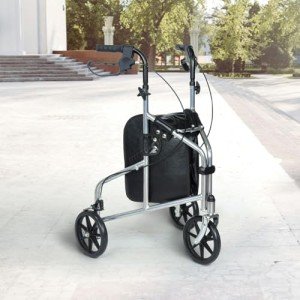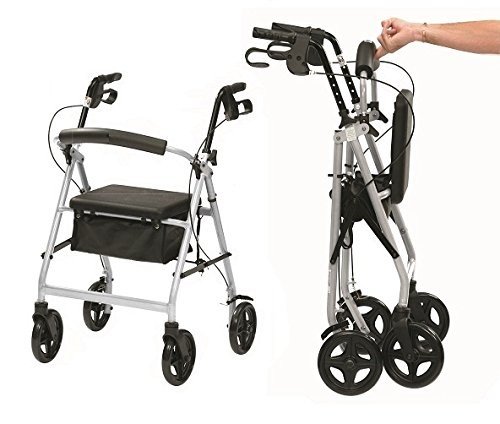This company has no active jobs
0 Review
Rate This Company ( No reviews yet )
About Us
How Can A Weekly Rollator For Walking Project Can Change Your Life

Understanding Rollators for Walking: A Comprehensive Guide
Rollators are a vital mobility aid that enhances the freedom and independence of those with restricted walking capabilities. They are developed not just to offer stability and assistance however likewise to encourage mobility and engagement in everyday activities for people of any ages. This short article delves deep into the world of rollators, offering insights into their functions, benefits, types, upkeep, and crucial considerations when picking the most ideal design.
What is a Rollator?
A rollator is a mobile walking aid geared up 6-Wheel Sit & Go Shopping Trolley with Seat (Full Article) 4 wheels, handgrips, a seat, and frequently features extra features such as storage baskets and brakes. Unlike conventional walkers, which require the user to lift them off the ground, rollators can be pressed along as the user walks, making them especially helpful for people with restricted strength or balance.
Secret Features of Rollators
Rollators include a number of features that enhance their use:
- Wheels: Most rollators include swivel or fixed wheels for better maneuverability inside and outdoors.
- Brakes: Hand brakes enable users to manage their speed and stop safely.
- Seat: Many rollators supply a built-in seat for users to rest when needed.
- Lightweight Frame: Constructed from lightweight products, rollators are simple to raise and transfer.
- Adjustable Height: Most rollators enable for height modifications to accommodate the user’s stature.
Benefits of Using a Rollator
Utilizing a rollator uses numerous advantages, particularly for seniors and people with mobility challenges. These might consist of:
- Improved Stability: Rollators provide a stable base that assists prevent falls.
- Increased Mobility: Users can move about more freely, whether inside your home or outdoors.
- Boosted Independence: With a rollator, users can carry out daily tasks without needing help.
- Hassle-free Seating: The schedule of a seat enables users to rest whenever they feel tired.
Kinds of Rollators
When considering which rollator to choose, it’s important to acknowledge the numerous types readily available. The main categories consist of:
- Standard Rollators: Typically have four wheels and a seat, appropriate for many indoor and outdoor environments.
- Durable Rollators: Designed for bigger individuals, these rollators have strengthened frames and higher weight capacities.
- Three-Wheel Rollators: These provide a more lightweight and compact alternative, making them perfect for narrower areas.
- Foldable Rollators: Convenient for transport, these designs can be easily collapsed and stored when not in use.
| Type of Rollator | Description | Best For |
|---|---|---|
| Standard Rollator | 4 wheels, seat, many alternatives. | General use, indoor and outdoor. |
| Durable Rollator | Enhanced for greater weight capability. | Larger individuals needing extra assistance. |
| Three-Wheel Rollator | Compact and lightweight, easy to maneuver. | Restricted space and indoor use. |
| Foldable Rollator | Collapsible for easy transport. | Regular travelers or caretakers. |
How to Choose the Right Rollator
Choosing the best rollator involves thinking about numerous elements to fulfill the person’s specific requirements:
- Weight Capacity: Ensure the rollator can support the user’s weight.
- Height Adjustability: Look for models that can be gotten used to the user’s height for ideal convenience.
- Features Needed: Consider whether additional features like baskets, trays, or hand brakes are necessary.
- Meant Use: Determine if the rollator will be primarily utilized inside, outdoors, or both.
Maintenance Tips for Rollators
To extend the life expectancy and performance of a rollator, regular maintenance is important. Here are some useful pointers:
- Check Brakes: Regularly test brakes to ensure they engage effectively.
- Examine Wheels: Look for indications of wear and tear; wheels need to roll smoothly.
- Clean Regularly: Wipe down the frame and elements to avoid dirt accumulation.
- Tighten up Bolts: Periodically check and tighten any loose bolts or screws.
Frequently Asked Questions (FAQs)
1. Can rollators be utilized on unequal surface areas?
Yes, numerous rollators are developed with bigger wheels or specialized treads to manage uneven surfaces. Nevertheless, users should work out care and guarantee they feel stable when navigating such surfaces.
2. How do I measure the correct height for a rollator?
When standing straight, the deals with of the rollator must line up with the user’s wrist when their arms are relaxed at their sides. This position makes sure comfortable use.
3. Do I require a prescription to purchase a rollator?
No, rollators can be bought without a prescription. Nevertheless, seeking advice from a healthcare expert can be beneficial to identify the best choice based on specific requirements.

4. Are rollators covered by insurance coverage?
Coverage for rollators can vary based upon the kind of insurance plan. Lots of Medicare strategies offer protection for some types of walkers, including rollators. It’s advisable to check with the insurance company straight.
Rollators for walking considerably improve the lives of lots of people dealing with mobility challenges. Providing stability, self-reliance, and ease of motion, they work as crucial tools for keeping an active way of life. Understanding the different types, functions, and how to keep them in good condition can empower users in making notified decisions. As mobility needs vary greatly from person to individual, it is important to pick a rollator that best fulfills private requirements and enhances quality of life.


